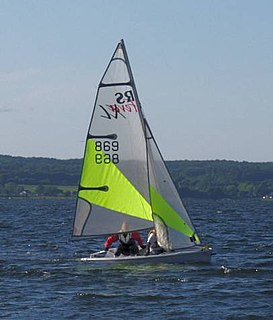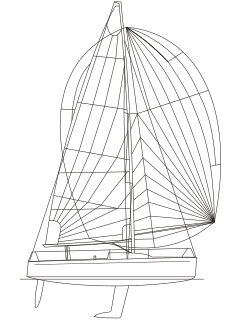
World Sailing (WS) is the world governing body for the sport of sailing recognized by the International Olympic Committee and the International Paralympic Committee (IPC).

The Star is a 6.9 metres (23 ft) one-design racing keelboat for two people designed by Francis Sweisguth in 1910. The Star was an Olympic keelboat class from 1932 through to 2012, the last year keelboats appeared at the Summer Olympics.

The International 2.4mR is a one-person keelboat. The class is a development class governed by the 2.4mR rule. The rule is controlled by World Sailing (ISAF) since it is one of few classes designated as an International class. The class rule is closely related to the 12mR rule that was used in the America's Cup and the shape often resembles the larger sister.
Sailing/Yachting is an Olympic sport starting from the Games of the 1st Olympiad. With the exception of the 1904 and the canceled 1916 Summer Olympics, sailing has always been included on the Olympic schedule. The Sailing program of 1908 was open for a total of five sailing classes (disciplines), but actually only four Sailing events were contested. The planned venue of all races, named matches, was Ryde, Isle of Wight.

The International 505 is a One-Design high-performance two-person monohull planing sailing dinghy, with spinnaker, utilising a trapeze for the crew.

Model yachting is the pastime of building and racing model yachts. It has always been customary for ship-builders to make a miniature model of the vessel under construction, which is in every respect a copy of the original on a small scale, whether steamship or sailing ship. There are fine collections to be seen at both general interest museums such as the Victoria and Albert Museum in London and at many specialized maritime museums worldwide. Many of these models are of exquisite workmanship, every rope, pulley or portion of the engine being faithfully reproduced. In the case of sailing yachts, these models were often pitted against each other on small bodies of water, and hence arose the modern pastime. It was soon seen that elaborate fittings and complicated rigging were a detriment to rapid handling, and that, on account of the comparatively stronger winds in which models were sailed, they needed a greater draught. For these reasons modern model yachts, which usually have fin keels, are of about 15% or 20% deeper draught than full-sized vessels, while rigging and fittings have been reduced to absolute simplicity. This applies to models built for racing and not to elaborate copies of steamers and ships, made only for show or for " toy cruising."

The International rule, also known as the Metre rule, was created for the measuring and rating of yachts to allow different designs of yacht to race together under a handicap system. Prior to the ratification of the International rule in 1907, countries raced yachts under their own national rules and international competition was always subject to various forms of subjective handicapping.

The IMOCA 60, is a development class monohull sailing yacht administered by the International Monohull Open Class Association (IMOCA). The class pinnacle event are single or two person ocean races, such as the Route du Rhum and the Vendée Globe and this has been intimately linked to design development within the class.

The Dragon is a one-design keelboat designed by Norwegian Johan Anker in 1929. In 1948 the Dragon became an Olympic Class, a status it retained until the Munich Olympics in 1972. The Dragon's long keel and elegant metre-boat lines remain unchanged, but today Dragons are constructed using the latest technology to make the boat durable and easy to maintain. GRP construction was introduced in 1973 and the rigging has been regularly updated.

The RS Feva is a two-person sailing dinghy designed by Paul Handley in 2002. It is manufactured and distributed by RS Sailing. The RS Feva is an International Sailing Federation (ISAF) International Class, a Royal Yachting Association (RYA) Supported Junior Class, and has been selected by the Dansk Sejlunion and Norges Seilforbund for major sailing growth projects.

The RS Tera is a one-man monohull dinghy in the RS Sailing range of sailing boats. It is recognised by the International Sailing Federation (ISAF) as an international class, and is a popular boat for beginners and for children to race.

RS Sailing is an international designer, builder and supplier of sailboats and dinghies and associated goods and services supported by a worldwide dealer network and class associations.

The Farr 30 was designed by Farr Yacht Design led by Bruce Farr. The first boat was built by Carrol Marine and first launched in 1995. The class was recognised by the World Sailing from 1997 to 2018.
The International Radio Sailing Association (IRSA) formerly the ISAF Radio Sailing Division is an affiliate member of the International Sailing Federation that sanctions radio-controlled sailing competitions. It is authorised by ISAF to conduct up to three official World Championships each year.
The International One Metre (IOM) is a class of Radio Sailing Boat used for racing under the World Sailing - Racing Rules of Sailing. It is a measurement-controlled box rule originally created by the ISAF-RSD in 1988 in an attempt to harmonise the various one metre rules created around the world. The IOM Class Rules specify a standardised sail plan and control of the other major performance dimensions while allowing some freedom in hull design. The IOM is now the largest and arguably most competitive of all radio sailing classes.

The Transpac 52 (TP52) is a class of yacht used for competitive 52 Super Series yacht racing, and the Audi MedCup previously, besides the world championship of the class. The class is recognised by the International Sailing Federation which entitles the class to hold an Official World Championships.
The International Marblehead is a class of radio controlled sailing yacht used for competitive racing. It is a measurement controlled class administered by the International Radio Sailing Association.
The International 10 Rater (10R) is a class of radio controlled sailing yacht used for competitive racing. It is a measurement controlled classes administered by the International Radio Sailing Association. The class is a designated IRSA International class entitled to hold World Championships officially recognised by the World Sailing. A 10 rater is the longest and tallest of all the international classes and has rules that allow the most scope for development.

The Platu 25 is a sailing boat designed by Farr Yacht Design led by Bruce Farr with the first boat being built by McDell Marine in New Zealand in the early 1990s. It became a class recognised by the International Sailing Federation in November 2006.
The Turkish Sailing Federation (TYF) is the national governing body for the sport of sailing in Turkey, recognised by the International Sailing Federation.














